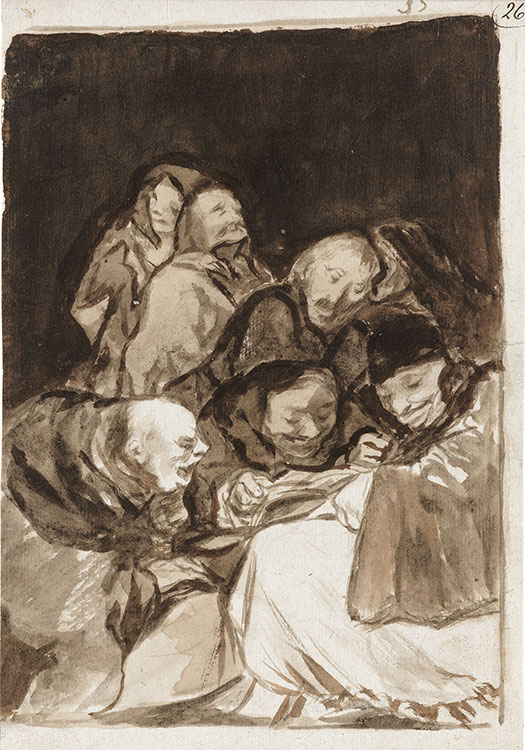Francisco de Goya

A group of monks, identified by their habits, pore over an open book; uneven light flickers across the scene, deftly rendered with brush and wash. The relationship and significance of the older man and younger woman standing together behind the main group, seemingly uninterested in seeing the volume, are ambiguous. The caricature-like faces and coarse delight of the three monks in the foreground imply that their book is not devotional and announce the drawing’s satirical nature. This sheet comes from one of several private albums that Goya compiled throughout his career. As in many of his published prints, the imagery in these drawings is replete with social criticism directed at the clergy, among others.
Francisco de Goya
Spanish, 1746–1828
Monks Reading, ca. 1812–20
Brush and brown wash
Kupferstich-Kabinett, Staatliche Kunstsammlungen Dresden, INV. NO. C 1910-56
© Kupferstich-Kabinett, Staatliche Kunstsammlungen Dresden
Photo: Herbert Boswank
John Marciari, Charles W. Engelhard Curator and Department Head
Francisco de Goya is best known for his paintings and his remarkable etchings, but he made some of his most personal and mysterious works in the drawing sketchbooks and albums that remained in his possession until his death. This was especially true late in his life, when a mysterious illness had left him deaf, and the Napoleonic wars had ended his close association with the Spanish court. The aging artist turned inward, producing scores of drawings like this work, and others that include satirical and cynical looks at contemporary life, alongside scenes of war, savagery, and witchcraft.
This sheet comes from an album that originally contained around 90 densely worked drawings made on writing paper with a brush and a corrosive brown ink, materials presumably adopted because of of good drawing paper and ink were not readily available during the war. In contrast to many of Goya’s drawings, those in this album generally do not have captions, and so they remain open to interpretation. Here, we see a group of seated monks in the foreground, but their coarse expressions suggest that their reading is something other than sacred literature. Behind them stand a woman, who seems to be hiding herself from the leering monks, and an older, apparently toothless monk looking upward, perhaps embarrassed by his companions or else because of his great age no longer interested in their activities.